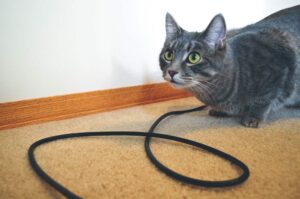 In April 2013, a Kansas school bus filled with children was driving down the road when it hit a slick spot and collided into a utility pole. With fallen power lines on and around the bus, the driver made the risky decision to evacuate the children. Luckily, the power lines were not energized.
In April 2013, a Kansas school bus filled with children was driving down the road when it hit a slick spot and collided into a utility pole. With fallen power lines on and around the bus, the driver made the risky decision to evacuate the children. Luckily, the power lines were not energized.
In 2009, two Indiana teenagers, Ashley Taylor and Lee Whitaker also got into a collision with a utility pole. With the vehicle on its side and power lines down, the teens did not know the lines were energized with electricity. These teens were lucky. Just days earlier they were learning about electrical safety at their school. They knew they had to stay in the vehicle.
These two events could have ended in tragedy, but luck saved one and knowledge saved the other.
National School Bus Safety Week is October 20-24, and National Teen Driver Safety Week is October 19-25. It’s a good time for making sure that you, your teen drivers, and anyone driving your children knows what to do if there is an auto accident with downed power lines. Luck may not always be on your side.
“When people are involved in a car accident, electricity is usually the last thing on their minds,” says Jim Miles, Safe Electricity advisory board member and Safety Instructor for the Association of Illinois Electric Cooperatives. “We’re often more concerned about whether anyone was injured or how badly the vehicle is damaged. We can forget that by exiting the vehicle, we’re risking bodily exposure to thousands of volts of electricity from downed power lines.”
Power poles carry high and potentially fatal levels of electricity. If you are in an accident with one, your vehicle may be charged with electricity. If you step out, you will become the electricity’s path to the ground and could be electrocuted. Loose wires and other equipment may be in contact with your car or near it — again creating a risk for electrocution if you leave the vehicle.
While downed lines can sometimes show they are live by arcing and sparking with electricity, this is not always the case. Power lines do not always show signs they are live, but are just as lethal.
“Our instincts in such a situation may tell us to get away if we can, but in most cases, getting out of the auto when power lines are down can be deadly,” explains Miles. “Until utility crews ensure the power is cut off, staying in the vehicle is safest.”
After an accident stay in the car, and tell others to do the same. Call emergency and utility services. Do not leave your vehicle until a utility professional has told you it is safe to do so.
The only circumstance when you should exit the vehicle is if it is on fire. If you must exit the vehicle, jump clear of it with your feet together and without touching the vehicle and ground at the same time. Continue to “bunny hop” with your feet together to safety. Doing this will ensure you will not have different strengths of electric current running from one foot to another.
If you come upon or witness an accident involving power lines, do not approach the accident scene. “Often our inclination is to step in and help those in danger and offer assistance to the injured,” Miles says. “However, in accidents involving power poles, the

best thing you can do is call for help. Wait for trained assistance to arrive, or you could become an additional victim in need of rescue.”
If you see someone approaching, warn them to stay away from the accident until utility professionals and emergency responders have confirmed there are no electrical dangers.
Safe Electricity encourages you to share what you know about electrical safety with friends, family, and new drivers so they will know what to do in a car accident with a power pole. For more information, visit SafeElectricity.org.







